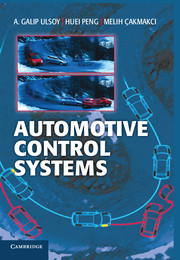Book contents
- Frontmatter
- Contents
- Preface
- Part I Introduction and Background
- 1 Introduction
- 2 Automotive Control-System Design Process
- 3 Review of Engine Modeling
- 4 Review of Vehicle Dynamics
- 5 Human Factors and Driver Modeling
- Part II Powertrain Control Systems
- Part III Vehicle Control Systems
- Part IV Intelligent Transportation Systems
- Appendices
- Index
- References
1 - Introduction
Published online by Cambridge University Press: 05 June 2012
- Frontmatter
- Contents
- Preface
- Part I Introduction and Background
- 1 Introduction
- 2 Automotive Control-System Design Process
- 3 Review of Engine Modeling
- 4 Review of Vehicle Dynamics
- 5 Human Factors and Driver Modeling
- Part II Powertrain Control Systems
- Part III Vehicle Control Systems
- Part IV Intelligent Transportation Systems
- Appendices
- Index
- References
Summary
The century-old automobile – the preferred mode for personal mobility throughout the developed world – is rapidly becoming a complex electromechanical system. Various new electromechanical technologies are being added to automobiles to improve operational safety, reduce congestion and energy consumption, and minimize environmental impact. This chapter introduces these trends and provides a brief overview of the major automobile subsystems and the automotive control systems described in detail in subsequent chapters.
Motivation, Background, and Overview
The main trends in automotive technology, and major automotive subsystems, are briefly reviewed.
Trends in Automotive Control Systems
The most noteworthy trend in the development of modern automobiles in recent decades is their rapid transformation into complex electromechanical systems. Current vehicles often include many new features that were not widely available a few decades ago. Examples include hybrid powertrains, electronic engine and transmission controls, cruise control, antilock brakes, differential braking, and active/semiactive suspensions.Many of these functions have been achieved using only mechanical devices. The major advantages of electromechanical (or mechatronic) devices, as opposed to their purely mechanical counterparts, include (1) the ability to embed knowledge about the system behavior into the system design, (2) the flexibility inherent in those systems to trade off among different goals, and (3) the potential to coordinate the functioning of subsystems. Knowledge about system behavior – in terms of vehicle, engine, or even driver dynamic models or constraints on physical variables – is included in the design of electromechanical systems. Flexibility enables adaptation to the environment, thereby providing more reliable performance in a wide variety of conditions. In addition, reprogrammability implies lower cost through exchanged and reused parts. Sharing of information makes it possible to integrate subsystems and obtain superior performance and functionality, which are not possible with uncoordinated systems.
- Type
- Chapter
- Information
- Automotive Control Systems , pp. 3 - 20Publisher: Cambridge University PressPrint publication year: 2012

